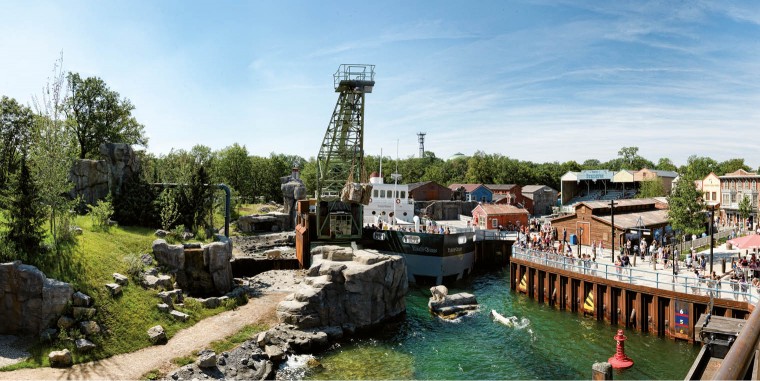“If knowledge is a bank and imagination the currency, the ultimate future investment is experience,” says Kieran Stanley, founder and associate of dan pearlman, the company behind the much-anticipated Islands development at Chester Zoo, England’s largest zoo development project, which opened in the summer.
Designing and investing in an experience was key to the project’s strategy from an early point in the planning and development of Islands. Visitors are taken on an immersive journey around six islands of South-East Asia, encountering indigenous wildlife in an, albeit recreated, native setting, as well as equipment like note books, sketches and observation posts along the way.
Based in Berlin and working internationally, dan pearlman creates brand and leisure environments that inspire and enrich
“By becoming part of the research team, we enabled the visitors to take on a different role and become actively involved in learning about the conservation work of Chester Zoo,” says Mr Stanley.
dan pearlman, based in Berlin and working internationally, creates brand and leisure environments that inspire and enrich. The 100-strong interdisciplinary company works in dialogue with its clients to develop holistic projects in a range of areas, including leisure, retail and wellness.
 Their portfolio includes such iconic projects as the BMW Welt in Munich, as well as the unique master plan development of Hanover Zoo with its immersive environments, including Yukon Bay or the world’s first amphibious safari through the Lost Valley at Everland Resort in South Korea, plus strategic development plans for Berlin’s Zoological Garden and Tierpark, among others. In fact, Mr Stanley says: “Our work turns brands into experiences and experiences into brands.”
Their portfolio includes such iconic projects as the BMW Welt in Munich, as well as the unique master plan development of Hanover Zoo with its immersive environments, including Yukon Bay or the world’s first amphibious safari through the Lost Valley at Everland Resort in South Korea, plus strategic development plans for Berlin’s Zoological Garden and Tierpark, among others. In fact, Mr Stanley says: “Our work turns brands into experiences and experiences into brands.”
When planning experiences such as Islands, he says, it’s crucial to look at things from a user’s perspective. This means sitting down with all the stakeholders, zoologists, curators, technicians and designers to determine what would make the experience work best for everyone. This is the basic principle of the “design thinking” process that the company as a strategic partner applies across all its projects.
By taking an integrative approach, dan pearlman is able to develop a unique solution that takes all areas into account. Zoological requirements, greater operative efficiency as well as the animals’ needs have to be considered. During the design process, dan pearlman comes up with behavioural enrichment innovations, such as the wave machine at Hanover Zoo which enables polar bears to “hunt” fish in a more natural way.
“Our simplest strategy was to offer the visitors a day’s holiday,” says Mr Stanley. “When you start looking at what that actually means for a whole family, you get a complicated and holistic list of needs and wants.” A zoo as a leisure environment poses an interesting challenge too as it’s one of the only places a family can be together all day so there’s a need to develop something everyone can enjoy.
Mr Stanley believes that through immersive engagement and experience, people can learn and understand quite complex content lightly, intuitively and sustainably. This is why in designing zoo and recreational facilities, creating a narrative is one of dan pearlman’s strong suits. “We tell stories by turning them into built reality,” he says. “Instead of defining architecture by its structure, we prefer to define it through a conscious choice in the sequence of space, light, content and experience, indoor and outdoor.”
This is similar to methods used in storytelling and scenography. But Mr Stanley prefers the term storybuilding to storytelling, explaining: “We build a story so it can be experienced in an intuitive manner, encountering things along the way and engaging with the content. Experiencing things first-hand anchors them cognitively with a relevance which ultimately is more sustainable.” Storybuilding, such as the Islands project, creates an emotional connection which enhances the visitor experience, but serves the goals of the client too, he says.

Another project in development is The Giant, the world’s largest moving statue and the biggest artistic sculptural project. On multiple levels, The Giant represents myths and legends, great historical figures, contemporary and fictional heroes, great inventions and developments.
The Giant is a great example of how a better outcome can emerge from collaboration. The client originally wanted a giant statue in every city – Einstein in Berlin, Dali in Barcelona, Warhol in New York. With dan pearlman on board, it’s become a museum, an iconic piece of architecture and an immersive attraction with relevance. Instead of just a piece of art, it’s now an experience that seeks to find out a person’s skills, passion and potential.
“The idea now is that everyone can be a giant and it serves to ‘awaken the giant in you’. This way the client receives something much greater than the initial brief and this is what we strive for,” Mr Stanley concludes. “In our work it is often less about themed entertainment and more about immersive engagement.”
danpearlman.com


